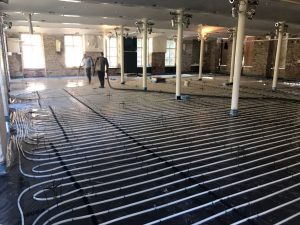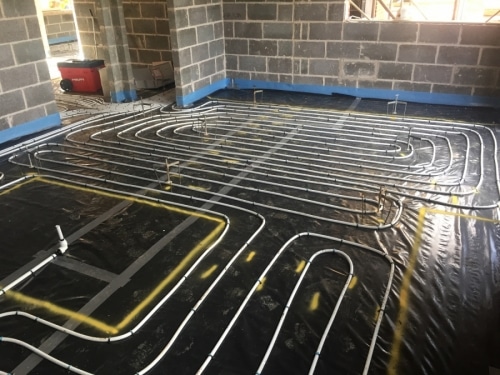An Expert Guide to Your Underfloor Heating System

A popular feature for a property’s floor in the modern day is the underfloor heating system. At Screed It, specialise in providing building projects with underfloor heating, alongside traditional and liquid forms of screed.
We’ve also put together this professional guide on underfloor heating so that you can be fully informed before you decide if you’d like this feature for your property.
What is an Underfloor Heating System?
Underfloor heating is a modern system of central heating and cooling, using either electricity through a series of thin wires or hot water in pipes to evenly distribute heat through a property’s floor.
In many cases, the pipes and wires used in underfloor heating will be set out in what is known as “S-plan”, as this shape of system is familiar to both plumbers and electricians.
How Underfloor Heating Systems Work
When you’re considering installing a new feature in a property, you will naturally want to know how it works first, so that you can then decide if the feature is suitable for your project and intentions. An S-plan underfloor heating system works by evenly distributing heat throughout your flooring, often taking advantage of the lack of air pockets in flooring material such as screed in order to ensure this is achieved. The heat level is then monitored by a thermostat in order to maintain a consistent temperature.
How systems work to distribute heat will all depend on whether your underfloor heating is wet or electric:
Wet Underfloor Heating Systems
Systems that use hot water to transfer heat into a room will allow this water to flow through a circuit of pipes underneath the finished floor design. The pipe layouts will then become hot, allowing for the heat to be transmitted to the room through the rest of the floor.
Any central heating source may be used for wet underfloor heating, including:
- Standard boilers
- Combination boilers
- Condensing boilers
- Biomass boilers
- Heat pumps
- Stoves
Electric Underfloor Heating Systems
Electric underfloor heating systems have an ultra-thin wire that will be installed underneath your flooring. This thin wire then heats up, serving the same purpose as the underfloor heating pipe for a hot water heating design.
The Benefits of Having an Underfloor Heating System

For many homeowners, no one will have explained all the benefits of having an underfloor heating system installed underneath their floor finish. There are many advantages to having this type of system installed for your property, which we have listed here:
- They allow for increased energy efficiency, by regulating temperature and ensuring that homeowners can turn down the thermostat on their central heating
- Their energy-efficient nature means that more money is saved from energy bills
- They will still be fully efficient underneath any floor layer added on top, whether you choose to put down tiles, carpet or timber flooring
- Water varieties will only need a minimal amount of maintenance, in the form of a regular flush and pressure testing
- Underfloor heating minimises the amount of dust circulated in a property, making them more comfortable for those with allergies or asthma
- S-plan systems in particular can make a property feel more comfortable in terms of temperature, as the heat is evenly distributed across the whole floor
- Damp and dust are eliminated, making them more hygienic
- They free up space by removing the need for radiator systems
How to Flush an Underfloor Heating System
Owing to how it works, you will need to regularly flush out any underfloor heating system that uses water. Like central heating systems, these pipes may have sludge and rust build up inside them over a long period of time and will need to be cleaned out in order to be kept in their best working condition. When this happens, you will have to power flush your system.
The process involves fitting a pump (the type that is best suited to your boiler) to your system, before sending cleaning chemicals through your pipes. This should clear them of any corrosion, sludge debris or rust that may have been preventing the system from working properly.
We do recommend that this work is carried out by an experienced professional, in order to ensure that the flush is performed correctly and safely.
Underfloor Heating Costs
The costs involved when you have an underfloor heating system can vary greatly, especially when the installation and overall running costs are also taken into account. Depending on the size of the area you have fitted your pipes or thin electrical wires, as well as daily and seasonal usage, the price you pay for your underfloor heating may fluctuate over time.
This difference will be especially prominent during summer and winter months, as the running costs will be lower in the months where you can safely turn the system off without feeling too cold in your home.
Contact Us for the Best Heating System for Your Property

If you have been looking at screed flooring for your property and you believe that your work project would benefit from a hot water-based underfloor heating system as well, get in touch with Screed It today. We’ll do everything we can to ensure that your wet system is delivered and installed exactly as you need it, underneath your planned floor coverings. We can do this anywhere in the UK, so there is no need to hesitate when you need a heating system with a wet design.
One of our staff will be happy to discuss the best options for setting out your system as soon as you get in touch.
FAQs
Can Underfloor Heating be Left on All the Time?
As we are often subject to very cold winters here in the UK, it is advisable to leave underfloor heating on all the time during the colder months. However, the temperature it should be left on will depend on individual circumstances, including how often the heating system is used and how much activity there is taking place in the building.
Underfloor heating may also take several hours to warm up, so turning it down to a reduced heat rather than turning it off is considered best for your property. This will ensure that any interior is warmed up at a faster rate when temperatures drop. You shouldn’t need to do this during warmer months of the year.
Can You Put Furniture on Underfloor Heating?
While it is possible to put furniture on top of hot water-based underfloor heating, flat-bottomed furniture must not be placed on top of electric UFH systems. This is because they risk covering the heating mat or cable, which can restrict airflow to the floor. In turn, this may lead to thermal blocking or even to the cable overheating, which can become a fire hazard.
Will Underfloor Heating Raise my Floor?
Because both wet and electric underfloor heating systems are installed directly beneath floor finishes, it may impact on the height of the floor once the work is done. However, this will be unnoticeable, as the system can be fitted with a layer of tile adhesive, or even placed in the subfloor itself.
